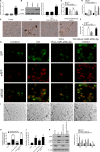Exosomes from miR-20b-3p-overexpressing stromal cells ameliorate calcium oxalate deposition in rat kidney
- PMID: 31489770
- PMCID: PMC6815912
- DOI: 10.1111/jcmm.14555
Exosomes from miR-20b-3p-overexpressing stromal cells ameliorate calcium oxalate deposition in rat kidney
Abstract
Hyperoxaluria-induced calcium oxalate (CaOx) deposition is the key factor in kidney stone formation, for which adipose-derived stromal cells (ADSCs) have been used as a therapeutic treatment. Studies revealed that miR-20b-3p is down-regulated in hypercalciuric stone-forming rat kidney. To investigate whether ADSC-derived miR-20b-3p-enriched exosomes protect against kidney stones, an ethylene glycol (EG)-induced hyperoxaluria rat model and an in vitro model of oxalate-induced NRK-52E cells were established to explore the protective mechanism of miR-20b-3p. The results showed that miR-20b-3p levels were decreased following hyperoxaluria in the urine of patients and in kidney tissues from animal models. Furthermore, treatment with miR-20b-3p-enriched exosomes from ADSCs protected EG-induced hyperoxaluria rats, and cell experiments confirmed that co-culture with miR-20b-3p-enriched exosomes alleviated oxalate-induced cell autophagy and the inflammatory response by inhibiting ATG7 and TLR4. In conclusion, ADSC-derived miR-20b-3p-enriched exosomes protected against kidney stones by suppressing autophagy and inflammatory responses.
Keywords: calcium oxalate deposition; exosomes; miR-20b-3p; microRNAs; stromal cells.
© 2019 The Authors. Journal of Cellular and Molecular Medicine published by John Wiley & Sons Ltd and Foundation for Cellular and Molecular Medicine.
Conflict of interest statement
All authors declare no conflicts of interest.
Figures





Comment in
-
Re: Exosomes from miR-20b-3p-Overexpressing Stromal Cells Ameliorate Calcium Oxalate Deposition in Rat Kidney.J Urol. 2020 Feb;203(2):246. doi: 10.1097/JU.0000000000000633. Epub 2019 Nov 5. J Urol. 2020. PMID: 31689150 No abstract available.
Similar articles
-
miR-103a-3p Silencing Ameliorates Calcium Oxalate Deposition in Rat Kidney by Activating the UMOD/TRPV5 Axis.Dis Markers. 2022 Feb 23;2022:2602717. doi: 10.1155/2022/2602717. eCollection 2022. Dis Markers. 2022. PMID: 35251369 Free PMC article.
-
Exosomes from miR-23 Overexpressing Stromal Cells Suppress M1 Macrophage and Inhibit Calcium Oxalate Deposition in Hyperoxaluria Rat Model.Biomed Res Int. 2023 Nov 16;2023:2883623. doi: 10.1155/2023/2883623. eCollection 2023. Biomed Res Int. 2023. PMID: 38027040 Free PMC article.
-
Re: Exosomes from miR-20b-3p-Overexpressing Stromal Cells Ameliorate Calcium Oxalate Deposition in Rat Kidney.J Urol. 2020 Feb;203(2):246. doi: 10.1097/JU.0000000000000633. Epub 2019 Nov 5. J Urol. 2020. PMID: 31689150 No abstract available.
-
Experimental calcium oxalate nephrolithiasis and the formation of human urinary stones.Scanning Microsc. 1995 Mar;9(1):89-100; discussion 100-1. Scanning Microsc. 1995. PMID: 8553028 Review.
-
Research progress on miR-124-3p in the field of kidney disease.BMC Nephrol. 2024 Aug 7;25(1):252. doi: 10.1186/s12882-024-03688-7. BMC Nephrol. 2024. PMID: 39112935 Free PMC article. Review.
Cited by
-
The therapeutic triad of extracellular vesicles: As drug targets, as drugs, and as drug carriers.Biochem Pharmacol. 2021 Oct;192:114714. doi: 10.1016/j.bcp.2021.114714. Epub 2021 Jul 30. Biochem Pharmacol. 2021. PMID: 34332957 Free PMC article. Review.
-
Sodium glucose co-transporter 2 inhibitor prevents nephrolithiasis in non-diabetes by restoring impaired autophagic flux.EBioMedicine. 2025 Apr;114:105668. doi: 10.1016/j.ebiom.2025.105668. Epub 2025 Mar 25. EBioMedicine. 2025. PMID: 40138887 Free PMC article.
-
miR-103a-3p Silencing Ameliorates Calcium Oxalate Deposition in Rat Kidney by Activating the UMOD/TRPV5 Axis.Dis Markers. 2022 Feb 23;2022:2602717. doi: 10.1155/2022/2602717. eCollection 2022. Dis Markers. 2022. PMID: 35251369 Free PMC article.
-
Propofol-induced MiR-20b expression initiates endogenous cellular signal changes mitigating hypoxia/re-oxygenation-induced endothelial autophagy in vitro.Cell Death Dis. 2020 Aug 13;11(8):681. doi: 10.1038/s41419-020-02828-9. Cell Death Dis. 2020. PMID: 32826852 Free PMC article.
-
Exosomes from miR-23 Overexpressing Stromal Cells Suppress M1 Macrophage and Inhibit Calcium Oxalate Deposition in Hyperoxaluria Rat Model.Biomed Res Int. 2023 Nov 16;2023:2883623. doi: 10.1155/2023/2883623. eCollection 2023. Biomed Res Int. 2023. PMID: 38027040 Free PMC article.
References
-
- Zeng G, Mai Z, Xia S, et al. Prevalence of kidney stones in China: an ultrasonography based cross‐sectional study. BJU Int. 2017;120:109‐116. - PubMed
Publication types
MeSH terms
Substances
LinkOut - more resources
Full Text Sources

